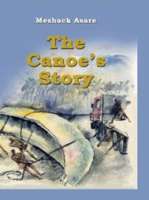
The Canoe’s Story
Written by Meshack Asare
Sub-Saharan Publishers, 2010, 63 pp.
ISBN: 978-9988647995
I started as a tree. I was a giant Wawa tree in the forest of the Hinterland. I was not the oldest tree but being one of the biggest in the forest, my roots went down hundreds of years. (p.1)
Told from the perspective of a giant Wawa tree, the beautiful descriptive words of Ghanaian native Meshack Asare describe the peacefulness of the forest before the arrival of man. However, once man arrives, many trees “wail” as they are cut down and hauled away. The tree recalls the animals they housed, the leaves that provided a rich forest floor for other growth, and the many lives saved by trees shielding men from guns. When the time comes for the narrating tree to be taken from the forest, he at first is fearful, but the men offer gifts, pray, and sing rhythmically as they take down the tree. The tree begins to rationalize the new life he will have and a sense of pride and adventure evolves as the men treat him with dignity.
A canoe is carved out of the huge tree while it is yet in the forest and the tree feels the admiration of the men. He eventually is moved to the ocean side where he is finished and christened with the name of Ka shi me, meaning in the Ga language, “never leave me.” As he is taken to the sea by the fishermen, he feels welcomed by the water, and the men bring back many fish. He is given gifts by the men in gratitude and at various times fitted with a sail and then a motor.
The tree shares a philosophical attitude as the story draws to a close. Rather than bitterness, he shares insight to the notion of interdependency. Just as creatures depended on him in the forest and he depended on other aspects of nature, so man depends on him. “We all depend on one another and it doesn’t matter what we are. It is what we do” (p. 53). Sensing his value, the tree concludes his story with a wish that people would take caution so that trees do not leave them.
This environmental story is told within the specific cultural context of Ghana and the traditional reverent ritual of crafting a canoe to support and feed families. However, it is universal in its message. The simplistic telling of the story through the personification of the tree reveals the importance of canoes to the lives of the fishermen as well as the great respect that these men hold for this source of their livelihood. While the story is told in a positive vein as the tree gathers excitement over time in becoming a canoe, the message of conservation prevails as the tree notes that the forest is suffering from so much felling of trees.
Meshack Asare first published books in and about Africa in 1968 and has won prestigious awards such as the Noma Award in 1982 and the 1999 UNESCO First prize for Children’s and Young People’s Literature in the Service of Tolerance for Sosu’s Call, which also won the IBBY Outstanding Books for Young People with Disabilities Award in 2001. With works that are translated into several languages, “Asare has been described as an imaginative storyteller and talented artist who skillfully weaves cultural tradition and daily realities of life into picture stories for children” (http://www.cca.ukzn.ac.za/index.php?option=com_content&view=article&id=413%3Ameshack-asare-ghana&catid=34&Itemid=19).
In addition to being written by this highly regarded Ghanaian author, Meshack Asare, the authenticity of The Canoe’s Story is supported by it recently being named to the prestigious IBBY (International Board on Books for Young People) Honour List which is published biannually and based on criteria established by IBBY as:
Books that are representative of the best in children’s literature from the country and that the books are suitable for publication throughout the world. It provides insight into the diverse cultural, political and social settings in which children live and grow and it can be used by all those involved with developing educational and literacy programmes and publishing initiatives to develop exemplary ‘international’ collections (http://www.ibby.org/index.php?id=270).
The Canoe’s Story can be used with other books by Meshake Asare to provide insights into the lifestyle of the people of Ghana as well as their cultural ideologies. These include: Sosu’s Call (1997), Nana’s Son, (2000), Meliga’s Day, (2000), or The Brassman’s Secret (1986/2002). The book can also be paired with stories that focus on environmental issues such as Planting the Trees of Kenya, The Story of Wangaraii Maathai (Claire A. Nivola, 2008); One Well, the Story of Water on Earth (Rochelle Strauss, 2007), or A River Ran Wild, an Environmental History (Lynn Cherry, 1992).
Janelle Mathis, University of North Texas, Denton, TX
WOW Review, Volume V, Issue 2 by Worlds of Words is licensed under a Creative Commons Attribution-NonCommercial-ShareAlike 4.0 International License. Based on work at https://wowlit.org/on-line-publications/review/v-2/

Congratulations to author Anne de Graaf and Eerdmans Books for Young Readers for today’s 2013 Batchelder Honor Book Award for Son of a Gun. The Batchelder is awarded by ALSC for the most outstanding books originally published in a foreign language in a foreign country, and subsequently translated into English and published in the United States. Read more at: http://www.ala.org/alsc/awardsgrants/bookmedia/batchelderaward